Case Report - (2023) Volume 9, Issue 2
Management of Permanent Immature Necrotic Tooth with Biodentine: A Case Report
Achabi Najoua*,
Chhoul H and
Hessissen H
Department of Dental Medicine, Mohammed V University, Rabat, Morocco
*Correspondence:
Achabi Najoua, Department of Dental Medicine, Mohammed V University, Rabat,
Morocco,
Email:
Received: 09-Mar-2023, Manuscript No. IPPDPD-23-15857;
Editor assigned: 13-Mar-2023, Pre QC No. IPPDPD-23-15857 (PQ);
Reviewed: 27-Mar-2023, QC No. IPPDPD-23-15857;
Revised: 09-May-2023, Manuscript No. IPPDPD-23-15857 (R);
Published:
16-May-2023, DOI: 10.36648/2471.3082.23.9.009
Abstract
Traumatic injuries in children are a frequent problem with the upper central incisor as the most
affected tooth. Endodontic management of the immature permanent tooth with incomplete root
formation and necrotic pulp is a challenge in endodontics. Apexification procedure is an endodontic
treatment option for management of immature permanent tooth with open apex.
The case report describes the successful apexification treatment of a 9 years old girl patient with
immature maxillary central incisor and crown discoloration, with the use of Biodentine as an apical
barrier matrix. Dental history of discontinued endodontic treatment 1 year back was remarked. A 12
months follow up using standardized digital radiographs revealed restored aesthetics and function,
absence of clinical signs.
Keywords
Apexification; Permanent immature tooth; Biodentine; Traumatic injury; Endodontics
Introduction
Dental traumatic injuries to young permanent teeth are
frequent, and mostly occurs before completion of the root
formation, and often results in pulpal inflammation or
necrosis [1,2]. Further, many complications can be lead such
as interruption of dentin formation and cessation of root
development [3]. Therefore, endodontic management of such
teeth imposes a great challenge because of thin dentinal walls
and wide open apex make biomechanical debridement and
obturation difficult [4].
Apexification is procedure for treating immature permanent
tooth with open apex. It is means a method to induce a
calcified barrier in a root with an open apex or continued
apical development of an incompletely formed root in teeth
with necrotic pulp tissue [5].
For many years, calcium hydroxide paste was used to induce a
calcified barrier followed by root canal therapy [6]. MTA is
commonly used nowadays as a material of choice for
apexification. One of the major problems posed by MTA is
handling properties and long time to set [7]. Not long ago, a
new calcium silicate based material, biodentine (Septodont,
France), has been introduced which was designed as a “dentin
replacement” material with properties similar to MTA without
its disadvantages [8]. The aim of the present article is to
report the successful management of a maxillary central
incisor wide open apex using biodentine.
Case Presentation
A female, aged 9 years reported to our department of pediatric dentistry, dental consultations and treatments center, Mohammed V university in Rabat, Morocco. Her main complaint was pain related to tooth 21 as well as esthetic problem. The dental history revealed a trauma to the anterior maxillary region at the age of 7 years. The patient promptly provided a history of root canal therapy which was performed one year ago by a dental quackery. She did not present any systemic, local genetic diseases or medication history. The extra oral examination was normal. Intraoral examination revealed defective resin composite restoration on teeth 21, and showed an access cavity already done, with a clear discoloration (Figure 1). The vitality of the tooth was determined by the cold thermal testing, using dry ice. It revealed the negative response, whereas response was obtained on adjacent teeth. The tooth was tender to percussion with a physiological mobility.
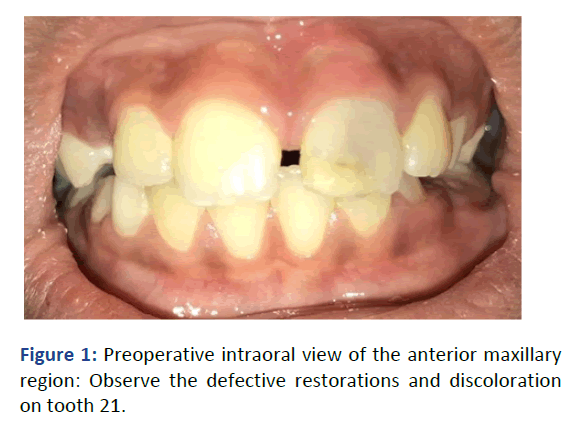
Figure 1: Preoperative intraoral view of the anterior maxillary region: Observe the defective restorations and discoloration on tooth 21.
The radiographic examination of the tooth revealed incomplete obturation of the canal with an immature open apex, a marked lateral radiolucency between teeth 11 and 21, an irregular margin and loss of lamina dura (Figure 2).
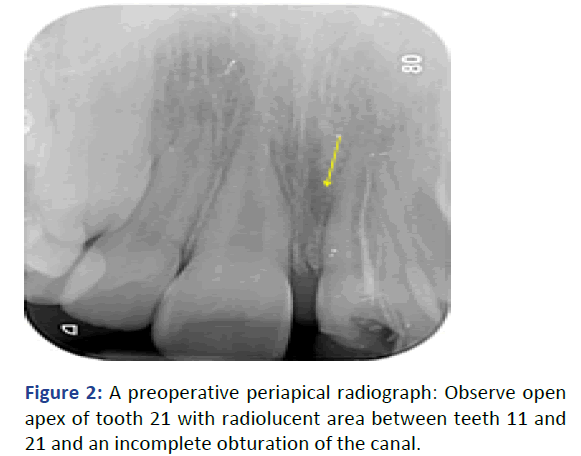
Figure 2: A preoperative periapical radiograph: Observe open apex of tooth 21 with radiolucent area between teeth 11 and 21 and an incomplete obturation of the canal.
The diagnosis was a chronic apical periodontitis with an open apex. Apexification with Biodentine was planned as a treatment option. The setting period of the material is short (9-12 minutes) in contrast with MTA which is 2 hours 45 minutes. This quicker setting minimizes the risk of bacterial contamination and eliminates the need for a two-stage filling as with TMA. This avoids the patient a lot of back and forth [9].
The endodontic treatment started with the isolation of the tooth with a rubber dam, access to the pulp chamber was completed and a foreign object like a wooden wedge was removed from the canal. Then, the Working Length (WL) was easily determined using a file in place radiograph. The canal was then cleaned and shaped gently using rotary protaper under NaOCl 2.5% irrigation and dried using paper points. Calcium hydroxide was placed in order to obtain disinfection of the root canal, and removed after 2 weeks (Figure 3).
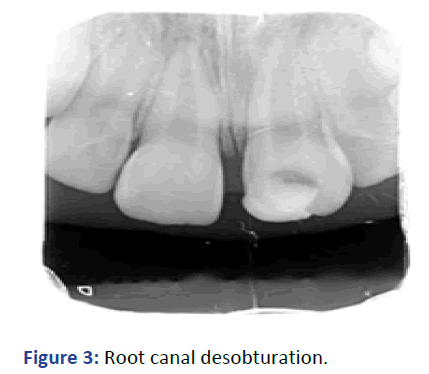
Figure 3: Root canal desobturation.
Biodentine was mixed according to manufacturer’s instructions; it was obtained by adding 5 drops of fluid to the powder and triturating for 30 seconds in electric amalgamator. Then, it was carried into the canal using amalgam carrier and condensed to obtain a 5 mm apical plug using hand pluggers.
To check the correct position of the biodentine mixture, an Xray control was done immediately. On this radiograph, we can see the low radiopacity of biodentin which appears close to that of dentin.
The rest of the canal was obdurate with thermoplastic zed gutta-percha. On the recall visit, post endodontic restoration with composite was done. The final result can be seen in (Figures 4 and 5).
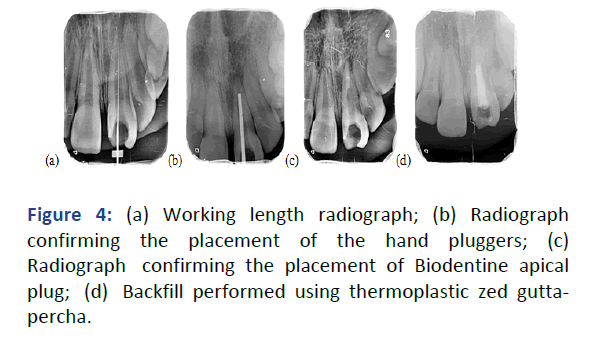
Figure 4: (a) Working length radiograph; (b) Radiograph confirming the placement of the hand pluggers; (c) Radiograph confirming the placement of Biodentine apical plug; (d) Backfill performed using thermoplastic zed guttapercha.
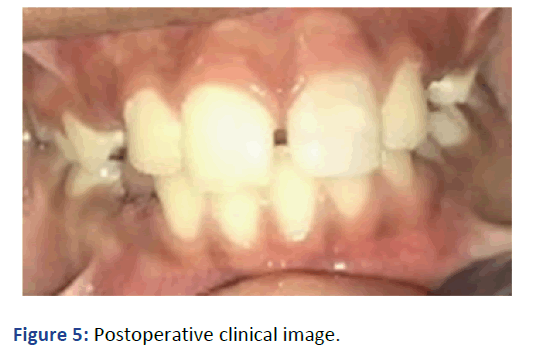
Figure 5: Postoperative clinical image.
One year follow-up revealed the patient remained asymptomatic with restored esthetics and functions.
Discussion
According to the American association of endodontist’s
glossary of endodontic terms, apexification is defined as “a
method of inducing a calcified barrier in a root with an open
apex or the continued apical development of an incompletely
formed root in teeth with necrotic pulp” [10]. Different
materials have being proposed for the apical plug formation.
Traditionally, calcium hydroxide was the most common
material used in apexification [11]. Chowdhury AFMA., thanks
to its ability to induce the formation of a calcifed apical
barrier. However, despite its success, technical apexication
with this material has many inconveniences. It requires
multiple visits and a long term to obtain the apical barrier (6
to 24 months), recontamination of the root canal system
during treatment periods is likely. It can lead also to a high risk
of root fractures [12]. With the discovery of MTA, it becomes
the material of choice for apexification. MTA is bioactive
cement with the capacity to induce the formation of new
cementum and periodontal ligament. The advantages of MTA
apexification are: Low solubility, excellent biocompatibility,
greatest radiopacity. It may also be able to reduce the number
of clinical sessions thus offering the possibility to restore the
tooth with a minimal delay [13]. But does not allow the root
edification, and the root fragility persists, it also presents a
poor handling characteristics, discoloration potential and high
cost.
Recently, Biodentine with active biosilicate technology
was introduced in 2010, as a new class of dental
material. Biodentine is a Tricalcium Silicate (Ca3SiO5) based
in organic restorative commercial cement and advertised
as ‘bioactive dentine substitute’ [14]. It is characterized by
a compressive strength, elasticity modulus, and micro
hardness comparable with that of natural dentine (add the
values comparatives). A micromechanical bond between
dentin and this novel material can be observed thanks to
the creation of a tag like crystalline structure within the
dentinal tubules. In addition, Biodentine has a shorter
setting time of 12 min as compared with that of MTA (2
hours and 45 min). Then, the completion of treatment on the same day is made possible unlike MTA, which requires a
two-step technique. The biodentine has the ability of creating
a tag like crystalline structure within the dentinal tubules
which may contribute to the micromechanical bond between
dentin and novel calcium silicate material [15]. The presented
case shows a management of an immature permanent tooth
with the latero-apical lesion, with one-year follow-up using
biodentine for apexification (Figure 6).
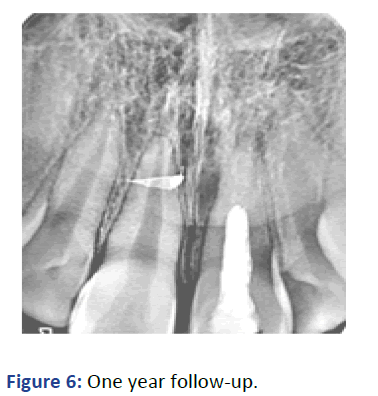
Figure 6: One year follow-up.
The aim of our treatment is to exploit the best of both,
calcium hydroxide and Biodentine properties. Calcium
hydroxide was used, for 15 days, as a temporary obturation
materiel in order to obtain disinfection of the root canal, and
periapical healing, without his adversely affect the fracture
resistance of the tooth. Whilst, Biodentine was used as an
artificial apical barrier.
Conclusion
Apexification treatment with biocompatible materials such as
Biodentine can be considered an effective treatment option
for teeth presenting open apices. This is due to its excellent
physical, mechanical, and biochemical properties, along with
superior clinical handling capabilities. However, in such cases,
long term follow up is necessary to ensure and evaluate
success.
References
- Arvind KA, Mohanapriya R (2019) Endodontic management of open apex using biodentine for inducing artificial apical plug. J Bio Innov. 8(5):625-630.
- Bouaziz S, Zekri H, Bhouri L (2017) Global management of a traumatic immature central incisor with an open apex and crown discoloration. Oral Health Care. 2(4):1-6.
[Google Scholar]
- Varghese VS, Uppin V, Kurian N (2017) One step apexification of blunderbass canal using biodentin. Chrismed J Health Res. 4(4):280-282.
[Google Scholar]
- Aggarwal N, Bansal K, Bansal BP (2020) Biodentine for apical barrier for immature necrotic permanent teeth: A case report. Int J Oral Health Dent. 6(3):214-215.
[Google Scholar]
- Jaikaria A, Negi P, Kukreja S (2019) Apexification: Use of MTA and Biodentin to form apical barrier in immature permanent teeth. Int J Appl Dent Sci. 5(4):156-158.
[Google Scholar]
- Vidal K, Martin G, Aguilar G (2016) Apical closure in apexification: A review and case report of apexification treatment of an immature permanent tooth with biodentine. J Endod. 42(5):1-5.
[Crossref] [Google Scholar] [PubMed]
- Abu-Hussein M, Azzaldeen A, Mai A, Jabareen A (2017) Management of open apex in permanent teeth with Biodentine. J Dent Med Sci. 16(2):135-140.
[Google Scholar]
- Khanduri N, Kurup D (2018) Single visit apexification with Biodentine and platelet rich brin. Endodontol. 30:181-183.
[Google Scholar]
- Gurudutt N, Faiz Hasan M (2014) Biodentine-a novel dentinal substitute for single visit apexification. Restor Dent Endod. 39(2):120-125.
[Crossref] [Google Scholar] [PubMed]
- Gupta S, Pal S, Sodhi S, Brar K, Bansal NR. Endodontic treatment of immature tooth–a challenge. J Pre Clin Clin. 14(3):73-79.
[Google Scholar]
- Chowdhury AFMA, Alam A, Sarkar UK, Rabby MAI (2013) Apexification with calcium hydroxide: 27 months follow up of a case. Medicine today. 25(1):42-45.
[Crossref] [Google Scholar]
- Boufdil H, Mtalsi M, El Arabi S, Bousfiha B (2020) Apexification with calcium hydroxide vs. revascularization. Case Rep Dent. 2020:1-6.
[Crossref] [Google Scholar] [PubMed]
- Nimra I. Farooq S (2019) Mineral trioxide aggregate apexification: A Case Report. IJDSIR. 2(6):437-440.
- Bansal K, Jain A, Aggarwal N, Jain A (2020) Biodentine vs. MTA: A comparitive analysis. Int J Oral Health Dent. 6(3):201-208.
[Crossref]
- Srivastava P, Sawhney A, RohitSharma, Hans MK, Agarwal S, et al. (2020) Biodentine used as an apical barrier for the treatment of open apex. J Dent Res Rev. 7:147-150.
[Google Scholar]
Citation: Najoua A, Chhoul H, Hessissen H (2023) Management of Permanent Immature Necrotic Tooth with Biodentine: A Case
Report. Periodon Prosthodon. 9:009.
Copyright: © 2023 Najoua A, et al. This is an open-access article distributed under the terms of the Creative Commons
Attribution License, which permits unrestricted use, distribution, and reproduction in any medium, provided the original
author and source are credited.







